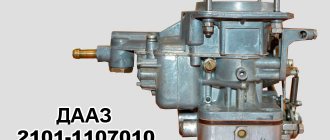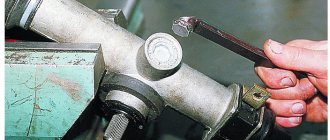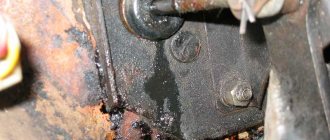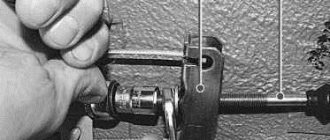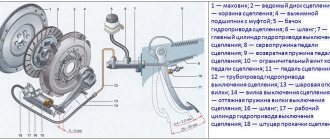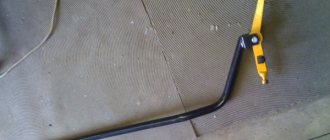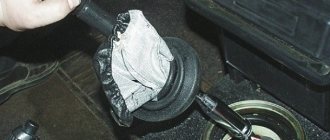The clutch pedal of the VAZ 2106 fails
- Registration
- Entrance
- To the beginning of the forum
- Forum Rules
- Old design
- FAQ
- Search
- Users
- List of forums AUTOLADA.RU
- "Classic"
You will progress as far as you can travel - Kh.Z.
True, on older machines, faults take a long time to develop, so you’ll most likely make it to the base . But perhaps not.
The hydraulic clutch assembly (pipe + master and slave cylinders) costs around 1000 rubles (when I changed it on an old car, I couldn’t unscrew the tube, I had to cut it and replace both cylinders), and it can be changed in a couple of hours.
They are not sold “assembled” - the tube is placed “in place”. The working cylinder is assembled - with a rod and boot. And it happens without them. It’s better to take it with a stock - it’s actually a consumable. You also need a rubber hose and a clip to secure it.
You can drive like this for a year and you will die smoothly. But such driving is terribly infuriating, especially in the city
before it was much lighter and grabbed closer to the floor
bleed the pedal became tight and began to grab at the end
How much longer can you drive like this?
I started to grasp at the end, before it was much easier and grabbed closer to the floor, your verdict, why is this?
After pouring drinking water into a Movil flask, it turned dark after a few minutes of shaking. Question: why did it darken and is it safe to drink now? Is it possible to use a flask of dirty water as a pressure when making a herbarium album?
Let's get to the point: does the hydraulic drive work now or not? If you don’t like the color, change the brake until it clears up (which is unlikely) - but if you’re concerned about aesthetics, you can change the floor of the car
Almost the same problem. In the morning the clutch pedal is half empty. It started up, warmed up a little and that’s it, the clutch works fine. While driving, sometimes dips appear, but immediately disappear.
The symptoms appeared after standing in a traffic jam on an uphill highway. Looks like I set the disk on fire.
The clutch pedal falls all the way when pumping on a VAZ
- How to nap the chipping cylinder on a VAZ 2101? – 5 answers
- The clutch doesn't work well! – 4 answers
- It is difficult to change gears on a VAZ 2101 - 3 answers
- I can’t bleed the VAZ clutch – 3 answers
- Clutch disappears - 2 answers
How to bleed the clutch is described below or provided in this article; if the clutch does not bleed or does not engage, then the problem may be in the clutch master cylinder (MCC), in the clutch slave cylinder.
If anything, then repair - replacement of hoses, replacement of cuffs
The pedal falls, but the clutch does not release, then this means there is air in the hydraulic system. Or the cuffs in the clutch master cylinder have worn out and are leaking brake fluid.
Previously, when there was a shortage of spare parts. parts, bought cuffs, removed and sorted out the main clutch and clutch slave cylinder. But this did not always help, because the cylinder mirror also wears out, and the seal could not be obtained even with new cuffs. Time was wasted on rearranging the cuffs in vain and we had to look in stores for a new clutch master cylinder or clutch slave cylinder.
With the clutch slave cylinder it is easier, or rather faster, it was clear if it does not work, the cuffs are leaking, then it is wet, the fluid decreases in the reservoir. If you still go through it and install new cuffs, then after filling the brake fluid you will also see whether the new cuffs are holding or not (meaning, if they don’t hold, then there will be leaks from the cylinder, it will get wet again and not work).
But with the master cylinder it may be different. Let’s say the working cylinder is working properly, that means there is “trouble” in the main circulation system. If the cuff that is closer to the passenger compartment is worn out and the brake fluid leaves the reservoir, then dampness will appear in the passenger compartment, where the rod enters the clutch from the pedal, through the engine shield. If the interior is dry, in the sense that fluid does not come out near the rod, and there is no decrease in the reservoir, and there is no pedal pressure, the clutch does not disengage, then the second cuff is worn out, it bypasses the brake fluid, the fluid is driven through the cylinder itself and is not pressed into the system. You can, of course, buy cuffs and sort out the main fluid circulation system, it may help, but maybe not if there is a large hole in the walls of the cylinder (sometimes an oval hole is packed). Now they make it simpler, buy a new cylinder and install it.
A small hint (but important): in order not to have to suffer for a long time with pumping the clutch, before installing the clutch, you need to pump it by hand, that is, pour the brake fluid into the reservoir and pump the piston several times with the piston pusher. As soon as the liquid flows out of the outlet, plug it and install the GCS in place. Then, when the cylinder is in place, remove the plug and connect the tube. A little brake fluid will leak out, but it’s not a big deal, you’ll need to add more to the reservoir, the main thing is that it doesn’t completely leak out of the reservoir, because if additional air gets through the reservoir, then again you’ll have to pump the air for a long time and persistently with the pedal.
And if the clutch is pumped and there is already brake fluid in it, then after installing it in place, the clutch starts working almost immediately; there is little need to pump. This is if the worker is in good working order and there is liquid in it.
If you only checked the working cylinder, then you don’t have to push it with the pedal for a long time either, just open the bleeder fitting and wait a few minutes. Monitor the brake fluid level in the master cylinder reservoir and top it up on time.
Well, actually, if you don’t miss the start of fluid flowing out of the working cylinder, then a little of it will flow out. Close the fitting. Test the clutch pedal. If everything is done carefully, then sometimes there is no need to bleed, the clutch works immediately, there is a release. Even if the squeeze is not full, in the sense that there is some air in the system, then bleeding does not take much time, it will quickly pump and the pedal will work as it should and the clutch will disengage.
Yes, if you installed a new clutch, then adjustment is needed on the clutch slave cylinder rod.
Exploitation
Thanks to its simple design, the clutch slave cylinder is quite durable and not subject to breakdown. The main malfunctions are associated with wear of rubber seals, which deteriorate from loads, exposure to low temperatures and brake fluid. If damaged seals are not replaced in time, dust and dirt that gets inside will damage the cylinder mirror, after which the brake fluid used in the hydraulic drive leaks out through micro-scratches, even if new clamps are installed. In this regard, it is advisable to inspect the working cylinder at every maintenance, and if drips appear, either repair it or replace it with a new one.
The working cylinder repair kit includes the necessary replacement parts for each specific model: boots, seals, retaining ring, and some kits may have a spare return spring, piston, rod.
A normally operating clutch cylinder does not manifest itself in any way and does not require any special precautions. Replacing it is quite simple and quick
There is no specific replacement schedule; the working cylinder will last as long as its technical reserve allows, as a rule, at least 150 thousand km.
The clutch pedal of the VAZ 2106 fails
Inveterate Zhigulist
Group: Zhigulists Messages: 715 Registration: 7/31/2008 From: Tomsk User No.: 4176 Car: Hyundai Accent Color: Blue Year of Issue: 2008 Thanks said: 4 times
Good day !
Something went wrong today. I was driving as usual, drove about 20 km from the start of the journey, and then before a turn I squeezed the clutch and the car almost stalled. The free play of the clutch pedal has increased by almost half of the entire travel. Somehow I got to work. When idling, you simply depress the clutch and the revolutions drop sharply from 2 thousand to 900. When you release, they return to place. I looked at the brake fluid and there are no drips, the level is normal. The working cylinder rod and fork move normally. I thought maybe it was bent or broken. I went to the service center for diagnostics. The serviceman looked and said that everything was ok with my clutch (like a fork, release and both cylinders). But I wasn’t there and I don’t know what he was watching. But I didn’t remove the box for sure. 1) Is it possible to determine whether the release valve is intact or not without removing the gearbox? I changed the fork boot, of course nothing changed.
Troubleshooting
The duration of the mechanism depends on many factors and can range from 5,000 to 200,000 km or more. Therefore, there is no exact time when this unit needs to be changed. Car mechanics and car repair specialists know several ways to check the wear of the clutch basket empirically, without resorting to disassembly.
The first sign of clutch basket wear is the so-called slippage, in which the worn driven disc does not press well against the flywheel. The degree of slippage is checked according to the following scheme:
- the car is put on the handbrake;
- the engine is started;
- high gear is engaged (3rd or 4th);
- Slowly release the right pedal and press the gas pedal.
If after pressing the gas pedal the car stalls, then everything is in order with the transmission unit being examined. If the engine continues to run, this means that the driven disk is badly worn and needs to be replaced.
The second method of checking is used when there is a suspicion that the clutch is not completely disengaged, but is “driving”. For diagnostics, we carry out the following sequence of operations:
- set the engine to idle speed;
- press the right pedal fully;
- turn on first speed or reverse.
If effort is required to engage the gear, and the mechanism itself makes extraneous noise during this operation, it means that the driven disk does not completely move away from the flywheel or, as mechanics say, “the clutch is moving.”
Diagnosis of clutch problems of a VAZ 2106 car without contacting a service station
The clutch, as a separate hydromechanical unit in a vehicle, is responsible for the interaction of the power plant and transmission. The clutch of the VAZ 2106 and the entire range of VAZ models with rear-wheel drive are no exception.
Clutch device
The “six” is equipped with a dry clutch with 1 disc, operating in a permanent closed mode. It is equipped with a spring pressure element located in the center and a vibration damping device located on the driven clutch disc. The mechanical section of the unit is a non-separable part, which includes a protective housing, a push-action clutch disc and a diaphragm-type spring. The protection housing is attached to the flywheel with special mounting-type bolts and pins. This disc is mated to the safety housing with 3 pairs of steel plates that connect the clutch disc and the protective housing part.
With the help of locking fasteners, the VAZ 2106 clutch basket (also known as a pressure disk) is articulated with the outer segment of a diaphragm-type spring. The spring itself is directly held on 2 rings of the protective housing part with rivets. The 12-sector standard clutch disc with driven slots is made of steel. Friction linings are connected to the sector elements of the product separately from each other. To attenuate passive torsion pulses, the VAZ 2106 clutch mechanism contains a damper located between the hub and the driven disc.
The hydraulic part of the mechanism consists of the GCC and RCS (clutch master and slave cylinders), as well as a clutch fork, a release bearing, a fluid reservoir and a clutch foot pedal with a spring. The reliability of the clutch mechanism, the price of which is quite high, depends not only on the length traveled during the period of operation, but also on the conditions of its functioning and the degree of load. If the clutch fails in a VAZ 2106, this means that, most likely, you will need to adjust the size of the free movement of the foot drive.
Sometimes it happens that the clutch pedal fails due to a break in the cable of this mechanism. If the VAZ 2106 clutch slips, then an accelerated wear process occurs, the so-called. "ferrado", i.e. friction linings of the disc, clutch basket diaphragm and flywheel interacting with the engine. The lack of free movement of the foot drive also indicates wear of the clutch basket. The dismantling and repair of this important unit can be seen in the film “VAZ 2106 clutch”, video instructions for which are presented in the next viewing frames on our Internet portal.
Clutch faults
There is a list of VAZ 2106 clutch malfunctions, which are presented in the table in this article. If the clutch is lost, you should look for a defect in the unit here:
Clutch faults
How to fix
The table shows the most common clutch malfunctions in practice.
Procedure for removing the mechanism
It is easiest to repair or replace the clutch basket when the entire engine is overhauled. If the power unit is removed, then you can inspect, repair or replace worn parts of this part of the car without much effort. In this case, dismantling the unit does not present any difficulties.
Let's take a closer look at how to disassemble the clutch and how to remove the failed part. The operation scheme is simple. The main thing is to comply with the technological regulations given below:
- First you need to remove the gearbox (gearbox). If the gearbox does not need to be repaired, then there is no need to disconnect the drives before removing the battery and mass flow sensor and draining the oil.
- Unscrew the drive (cable) that activates the mechanism and remove it.
- Unscrew and remove the starter.
- Unscrew the top bolts securing the box.
- Unscrew all electrical wiring harnesses and the speed sensor chip.
- Loosen the drive nut on the right side and completely unscrew the nut on the left side.
- Unscrew the suspension arm.
- Unscrew the ball joint.
- Remove engine protection.
- Remove the reverse signal switch chip.
- Unscrew the torque rod from the gearbox and remove the lower cover of the clutch housing.
- Loosen the nut of the gearbox control drive clamp and remove the rocker.
- Unscrew the lower bolts and gearbox mounting nut.
- Jack up the engine.
- Unscrew the gearbox from the pillow.
- Remove the box and gain access to the necessary component of the car.
The clutch on a VAZ 2106 is lost. The clutch pedal on a VAZ 2106 has failed
Help me please. The clutch pedal on a VAZ 2106 fell through, I looked into the fluid reservoir. It's empty. Can I just add liquid or what should I do? Is this fluid reservoir also used for the brakes? Maybe I braked and the fluid flew out somewhere through a pipe and because of this the clutch was lost? The clutch on the VAZ 2106 was lost.
Similar articles
32 comments on “The clutch on the VAZ 2106 is lost. The clutch pedal on the VAZ 2106 has fallen out”
First of all, you need to find the leak, fix it, then add fluid, bleed the clutch, and you’re good to go.
If my memory serves me right, there should be a separate tank there
Did you even understand what you wrote?
How can you drive like this and not look under the hood before leaving? You need to know basic things. And if there is no liquid in the reservoir, then what did you use to brake it? Handbrake? Or, before the trip, I decided to look under the hood, and oh my God, what do I see: there is no fluid in the brake reservoir.
Dmitry, what should I look there? Everything worked great, the liquid just flew out
Pavel, yes, exactly, there are 2 tanks there
Pull back the carpet under the steering column and check for signs of leakage from the master cylinder. Then dive down
Svyatoslav, where to go down? What should you watch?
As far as I remember, there are two barrels on the classic...
Dmitry, yes, that’s right, 2 tanks, I’ve already figured it out. What should I do with the clutch, where did the fluid go, what should I do now?
Pour the fluid into the reservoir, park the car in a clean place and press the clutch pedal... and you will see where it leaks...
Dmitry, Got it, thank you
Dmitry, do you put regular brake fluid in there?
Vyacheslav, working cylinder, oil seal leak
On the box, look at the clutch slave cylinder in the classic, this disease is starting to leak
Vyacheslav, it's too slow
Vyacheslav, of course I don’t know, I have a ten, but preferably the same one should be poured in...
Off-topic question, sorry, it's already frozen... the horn is constantly screaming, if you remove the relay, will it stop?
Diagnosis of clutch faults VAZ 2106 Zhiguli
Oiling of the flywheel, pressure plate, friction linings of the driven disk
Thoroughly wash oily surfaces with white spirit or gasoline and wipe them dry. Replace the heavily oiled driven disk. Eliminate the cause of oiling (oil leakage through the cuffs of the engine and/or gearbox)
Severe wear or burning of the friction linings of the driven disk
Replace the driven disk assembly
Reduced diaphragm spring force
Replace the pressure plate assembly with the clutch housing (“basket”)
The piston of the clutch master cylinder slowly returns to its original position due to swelling of the rubber cuffs
Replace the cuffs or cylinder assembly. If you suspect gasoline or other solvents have gotten into the clutch fluid, replace it
Incorrect clutch drive adjustment (full pedal travel is too small)
Adjust the drive. Replace the deformed clutch fork
Air has entered the hydraulic drive system (the pedal is “soft”)
Bleed the system, tighten connections
Loosening of rivets or breakage of friction linings, warping of the driven disk (end runout more than 0.5 mm)
Severe and uneven wear, scoring on the working surfaces of the flywheel or pressure plate
Grind or replace the flywheel. If the surface of the pressure plate is damaged, replace the housing with the pressure plate assembly (“clutch basket”)
Distortion or warping of the pressure plate
Replace the housing with the pressure plate assembly (“clutch basket”)
Jamming of the driven disk hub on the splines of the input shaft of the gearbox
Clean the splines from dirt, remove minor damage with a file. If the splines are significantly worn or damaged, replace the transmission disc and/or input shaft. Before assembly, apply CV joint grease to the splines
Release bearing jammed
Severe wear of the diaphragm spring blades at the point of contact with the release bearing
Replace the housing with the pressure plate assembly (“clutch basket”)
The clutch release fork is severely deformed or broken
Air in the hydraulic drive system
Bleed the system, tighten connections
Heavy wear and defects in the master cylinder mirror; dirt in the cylinder
Clean or replace the cylinder. During any maintenance, its cuffs should also be replaced.
Worn or defective cuff
Replace cuffs or cylinder assembly
Jamming of the driven disk hub on the splines of the input shaft of the gearbox
Clean the splines from dirt, remove minor damage with a file. If the splines are significantly worn or damaged, replace the transmission disc and/or input shaft. Before assembly, apply CV joint grease to the splines
Driven disk deformation
Replace the driven disk
Loose fastening of the friction linings of the driven disk, severe wear or cracks on the linings
Replace the driven disk
Loss of elasticity of the spring plates of the driven disk
Replace the driven disk
Significant settlement or breakage of torsional vibration damper springs, wear of windows for springs
Replace the driven disk
Seizures on the working surfaces of the flywheel or pressure plate
Replace the flywheel or clutch housing with pressure plate assembly (clutch basket)
Significant settlement or breakage of torsional vibration damper springs, wear of windows for springs
Replace the driven disk
Driven disk deformation
Replace the driven disk
Loose fastening of the friction linings of the driven disk, severe wear or cracks on the linings
Replace the driven disk
Worn, damaged release bearing or lack of lubrication
Plastic pedal bushings not lubricated
Lubricate the bushings with Litol-24 or CV joints-4
The plastic pedal bushings are severely worn
Replace the bushings; before installation, lubricate them with Litol-24 or CV joint-4
Air in the hydraulic drive system
Bleed the system, tighten connections
The pedal return spring has lost elasticity or is broken
The main culprit of the pedal not returning well to its place
Statistics of reviews from car enthusiasts on thematic forums show that in 95 cases out of 100, the cause of problems with the clutch pedal not returning well was “treated” by simply replacing the clutch master cylinder, sometimes without even trying to figure out the defect.
Upon opening and inspection, the following details of the pedal’s failure to return were established:
- In approximately 10% of all problem cylinders, a defect was found - an extremely small intake hole of the piston with a cuff, through which additional amount of brake fluid was sucked into the hydraulic circuit. When the piston stroke of the working cylinder increases due to adjustments or wear of the driven disk linings, the amount of fluid is simply not enough to return the internal piston spring to its rearmost position;
- A large amount of rubber dust suspended in the brake fluid was found in the cylinder and reservoir. It was this that often became the cause of abnormal behavior and poor return of the clutch pedal.
The first of these cases was treated quite simply and inexpensively. By enlarging the hole and removing the piston stroke limiter, the system began to receive the required amount of “brake fluid” to compensate for the increase in the volume of the working cylinder.
In the second episode, things are much more complicated. Disassembling and flushing the hydraulic circuit in the brake system will help for a short time. To eliminate the defect, it is necessary to replace all piston cuffs of both the working and master cylinders. As a rule, they all had worn out peripheral parts of the working surface of the rubber.
Due to the poor quality of the cuffs or the high roughness of the internal mirror of the master cylinder, catastrophic wear of the sealing edge of the cuff occurred, even when immersed in brake fluid. The resulting rubber dust regularly jammed the piston and prevented the clutch pedal from returning normally to its working position.
How to fix a stuck clutch on a VAZ 2106
guys, here’s the problem: the car has been in the garage for 8 years, it started driving under its own power, but the clutch got stuck over time and now I can’t push it (start it either) if I pull it with a truck, will the clutch come loose? and what can break from the jerking? (VAZ car 2108)
Life is full of surprises. And especially for motorists. Not only do you need to be constantly attentive on the road, but you also need to be able to notice and fix problems in your car in a timely manner. Especially when there are no populated areas nearby and the nearest service station is far away, or when you are stuck in a traffic jam and the clutch pedal is stuck or the brakes have disappeared.
This problem is a constant topic of discussion on many forums for car owners of almost all brands. Of course, a clutch can fail for many reasons. Let's look at the most common cases of problems with the clutch pedal of the VAZ 2106 and VAZ 2107.
Possible reasons for clutch pedal failure
The clutch pedal is depressed when depressed and does not return
This problem can be easily solved in stationary conditions either at a service station or with your own hands in the garage. To replace or repair the main clutch or control valve in the garage, you must have repair kits for the clutch slave and master cylinders.
Reasons for failure and non-return of the clutch pedal of VAZ2106 and VAZ2107:
- a break in the clutch cable where the tip touched. This problem is not easy to fix on your own. You can, of course, carry a spare cable with you just in case, but cases are different and it is not realistic to provide for everything;
- the spring that performs the function of returning the pedal to its original position may burst or fly off. If the spring has flown off, then it is enough to put it back in place, and if it has burst, then, as in the case of a cable break, you must either tow the car or try to get to the garage or service station under your own power.
How to drive a VAZ2106 or VAZ2107 without a clutch? We'll talk about this below:
What to do if the gear shift mechanism does not work?
If the clutch pedal fails on a road with heavy traffic, you should not be nervous, but act calmly with a “cool head” and get to the nearest parking spot, or even better, to a garage or service station. To do this, you can use a tug, tow truck, or drive yourself.
Driving style
It's also worth talking about driving style. Many novice motorists, as well as so-called reckless drivers, try to show their skills by starting at traffic lights or simply from a parking spot with the drive wheels slipping. As a result, this not only causes the clutch pedal to squeak, but also causes more serious damage. More or less experienced drivers do not do this, since such a driving style will certainly lead to the clutch pedal starting to fail. This will not happen soon, it will take some time, but the chance that the pedal will stick is one hundred percent. And now it’s worth talking about how, in the event of such a malfunction, you can get to your home or service.
